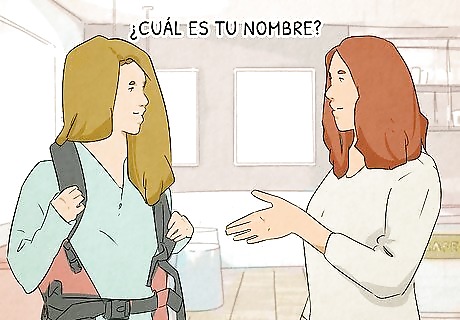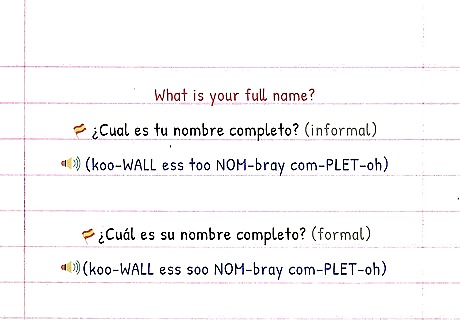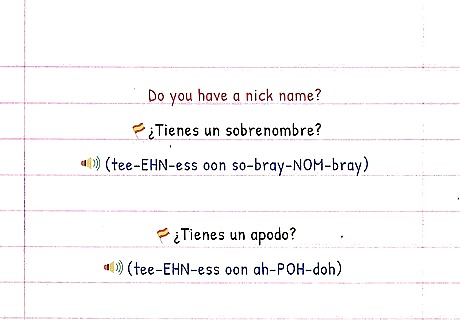
views
How to Say “What’s Your Name?” in Spanish

“¿Cómo te llamas?” (KOH-moh tay YAHM-ahs): This is the standard, informal way of asking what someone else’s name is in Spanish. You can use this expression in almost all contexts, with the exception of when you’re speaking to someone in a position of authority to whom you want to show respect. This expression literally translates to “What are you called?” Other languages that use the same kind of sentence structure to ask what someone’s name is include French and Russian.

“¿Cuál es tu nombre?” (koo-WALL ess too NOM-bray): For an alternative way of asking someone’s name, try this question. This is also an example of informal Spanish, which is what you’ll be using in most contexts, unless you’re in a very formal environment. The literal translation of this question is “Which is your name?” Beginner Spanish learners might try saying “what” instead of “which”, as in, “¿Qué es tu nombre?” (KAY ess too NOM-bray). Avoid this sentence: it sounds unusual to native Speakers.

“¿Cómo se llama?” (KOH-moh say YAHM-ah): This is the formal variation of “¿Cómo te llamas?” You can use this question when speaking with someone older than you, someone to whom you want to show respect, or when speaking to someone in a position of authority. For an even more formal way of asking this question, try including the pronoun “usted” (the formal “you”): “¿Usted cómo se llama?” (OO-sted KOH-moh say YAHM-ah). You might use this expression if you’re talking to a government official or figure of similar status. In Spain, you can also say “¿Cómo os llamáis?” (KOH-moh ohs yahm-ACE): This form of Spanish is not used in Latin America, but using it in Spain can make you sound more native.

“¿Cuál es su nombre?” (koo-WALL ess soo NOM-bray): This is the formal variation of “¿Cuál es tu nombre?” Try using this form of the question when speaking with someone to whom you want to show respect. It’s okay if you use informal Spanish instead of formal Spanish—this generally isn’t seen as being as rude as it is in other languages with a formal/informal distinction. In Spain, you can say “¿Cuál es vuestro nombre?” (koo-WALL ess voo-ESS-tro NOM-bray). This form of Spanish doesn’t exist outside of Spain, and speakers in Spain will also understand you if you use the Latin American dialect.
Possible Variations

“¿Cuál es tu apellido?” (koo-WALL ess too ahp-eh-YI-doh): This question translates into English as “What is your last name?” The formal variation of this question is “¿Cuál es su apellido?” (koo-WALL ess soo ahp-eh-YI-doh). In Spain, you can also ask this question in a formal way by saying “¿Cuál es vuestro apellido?” (koo-WALL ess voo-ESS-tro ahp-eh-YI-doh).

“¿Cual es tu nombre completo?” (koo-WALL ess too NOM-bray com-PLET-oh): Ask this question if you want to find out someone’s “complete name,” or their first, middle, and last names. Many Spanish speakers have multiple middle names, and this question helps you learn them. To ask this question in a formal style, say “¿Cuál es su nombre completo?” (koo-WALL ess soo NOM-bray com-PLET-oh). In Spain, you can also ask this question formally by saying, “¿Cuál es vuestro nombre completo?” (koo-WALL ess voo-ESS-tro NOM-bray com-PLET-oh).

“¿Tienes un sobrenombre?” (tee-EHN-ess oon so-bray-NOM-bray): This question translates into English as “Do you have a nickname?” Just like in English, many Spanish speakers have nicknames or pet names used by friends—try asking this question to see what they are. The formal variation for this question is “¿Tiene un sobrenombre?” (tee-EHN-eh oon so-bray-NOM-bray). In Spain, you can also use the formal variation of “¿Tenéis un sobrenombre?” (ten-EH-is oon so-bray-NOM-bray). Another word for “nickname” (“sobrenombre”) is “apodo” (ah-POH-doh). For example, “¿Tienes un apodo?” (tee-EHN-ess oon ah-POH-doh).
Introducing Yourself in Spanish

“Me llamo…” (meh YAM-oh): This sentence literally translates to “I am called…” but it is also the standard way to say your name in Spanish. For example: “¿Cuál es tu nombre?” “Me llamo Jack.” (“What is your name?” “My name is Jack.”)

“Mi nombre es…” (me NOM-bray ess): For an alternative response to the question “What is your name?” you can also use this expression, which literally means, “My name is…” For example: “¿Cómo te llamas?” “Mi nombre es Anastasia.” (“What is your name?” “My name is Anastasia.”)

“Soy…” (soy…): For a more casual response to the question, “What is your name?” try this expression. It means “I am…” and you can use it to introduce yourself in Spanish just like you would in English. “¿Cual es tu nombre completo?” “Soy Jackie Chen.” (“What is your full name?” “I’m Jackie Chen.”)




















Comments
0 comment